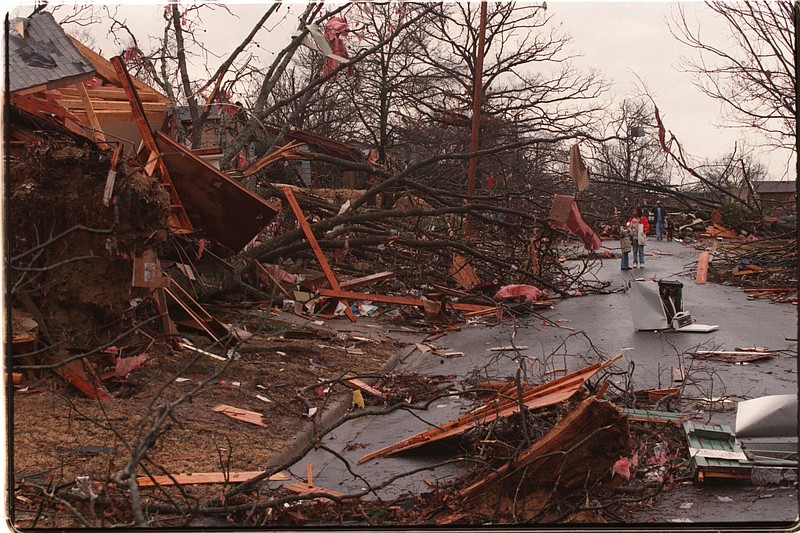The thing Shelle Stormoe remembers most vividly about the Jan. 21, 1999 tornado that tore through Little Rock's historic neighborhoods is how absolute, almost suffocating silence gives way to all-hell-breaking-loose noise ... and, in an instant, back to silence.
"It 100% did sound like a freight train," she says. "But it's like a freight train and then all the sound gets sucked out of everything. That's what makes it creepy; you have this giant wall of sound and wind, all this craziness and then it's completely silent. And the silence is because all the birds have flown off and all the normal things [went quiet].
"It's ... weirdly silent right before a tornado hits, too."
In 1999, Stormoe was married, finishing her last semester of college at the University of Arkansas at Little Rock, and living in an apartment on Sixth Street that backed up to Trapnall Hall not far from the downtown post office. From late morning, she recalls, it was apparent something major was headed their way.
"It was about 11 in the morning when it was pretty obvious that it was going to be a bad storm," she says. "Something was going to happen, but we just didn't know what."
The design of her apartment building led tenants to cluster in the hallway to ride out the tornado, away from the many windows of the individual units.
[RELATED: What to do before a tornado]
"Everybody in the apartment complex went into the hallway with their kids and their pets," she says. "We had a bunch of symphony people living in the building, and they had their musical instruments with them. Literally everyone and all their stuff that was precious was in the hallway."
According to UStornadoes.com, Arkansas averages almost 40 tornadoes in a typical year, and every one of them spawns dozens if not hundreds of survival stories. Enigmatic and fascinating, complex and terrifying, cyclones have reshaped the landscape of towns and communities from one end of the state to the other ... and not only dominated local news reports, but showed up on national ones.
Such as the tornadoes that hit in Northwest Arkansas in March; that swept through Jonesboro in 2020; that devastated Mayflower and Vilonia in 2014. Such as "the deadliest outbreak in Arkansas history" — March 21, 1952, when 112 people lost their lives, according to an article in The Encyclopedia of Arkansas, which goes on to tally the resulting deaths: more than 50 in Bald Knob and Judsonia and 29 in Cotton Plant in one of 17 tornadoes that day. Such as Brinkley's March 8, 1909 cyclone, which killed about 35 people, injured about 250 and resulted in uninsured property losses estimate to be more than $2 million, according to a Jan. 2 Democrat-Gazette guest column by Ray Hanley.
And, such as the tornado that hit Little Rock in 1999, part of the largest recorded tornado outbreak in state history.
Those who merely experience a tornado never forget it; those who get truly up close and personal with one are never the same.
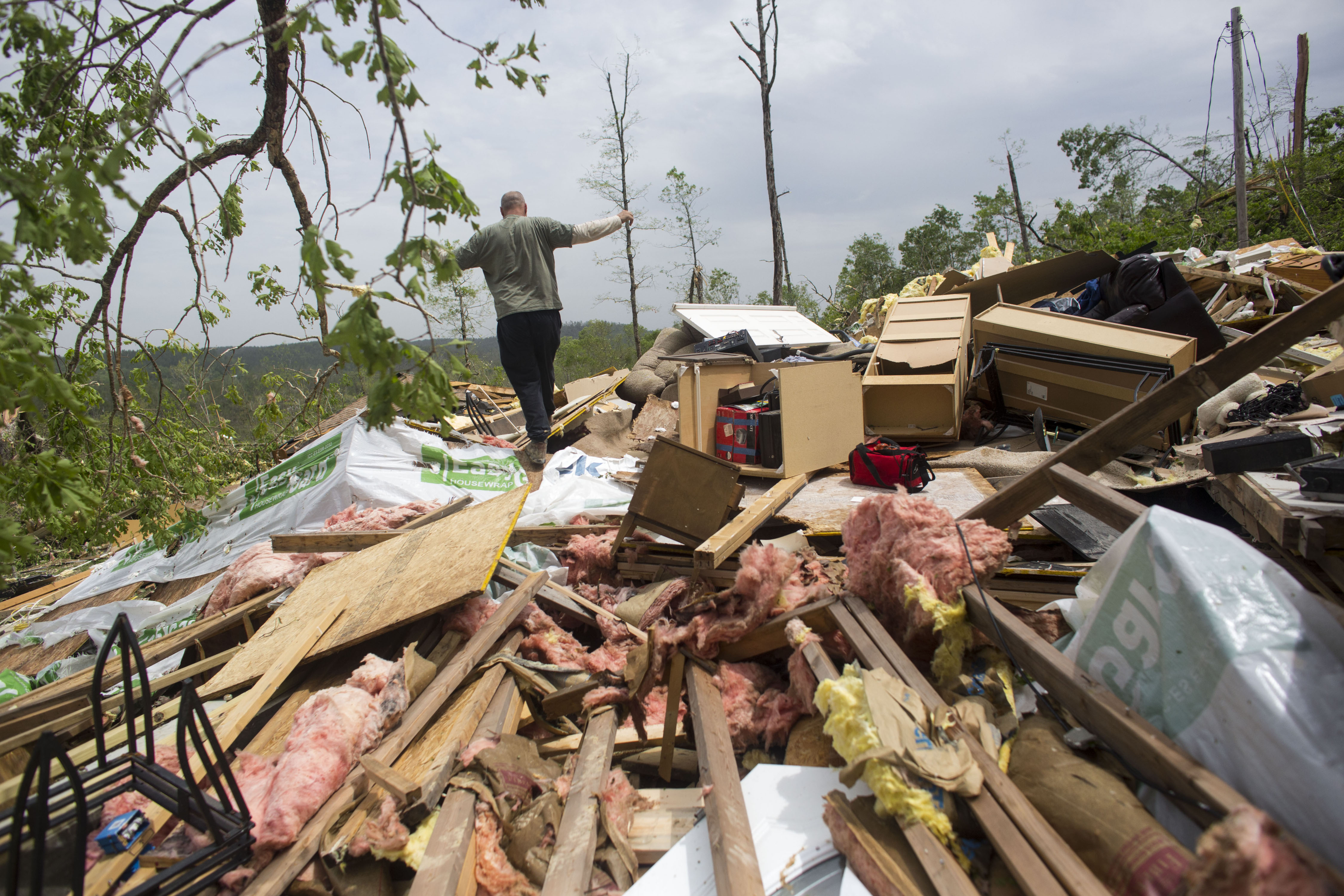 Joel Martin, who was renovating his home in Paron, walks over what’s left of it after surviving a 2014 tornado that left three dead on the same street. (Democrat-Gazette file photo)
Joel Martin, who was renovating his home in Paron, walks over what’s left of it after surviving a 2014 tornado that left three dead on the same street. (Democrat-Gazette file photo)
A NEAR-TRAGEDY
Stormoe's building did not suffer any damage and no one was hurt, but the complex did almost have one major tragedy.
"We had a new resident who had just moved in maybe two weeks before and she was from Hawaii," Stormoe says. "When everybody got into the hallway and told her what was going on, she dismissed us all and said she didn't believe in tornadoes. She went and got in her car and went to the grocery store. There were like 20 people telling her not to go, but she got in her car and she drove to the grocery store ... which is now Edward's on South Main." Then, it was a Harvest Foods.
"She was about to get to that intersection and the tornado hit the [Harvest Foods store] and destroyed it," Stormoe adds. "She came back and I've never seen anybody look more freaked out in my entire life than she was. I don't know how she managed to not get hit by it, honestly."
After it was over, with power out and darkness falling over the city, Stormoe and her husband at the time decided to take a look around.
"[The tornado] ran right through MacArthur Park, which was two blocks from us. It was really bad," she says. "We walked from our apartment to MacArthur Park and I had never seen anything like that ever. The trees were down. The roof was off the museum. I've never really seen anything like it in person before.
"It was very traumatic in the sense that there were houses that had been there for a hundred years that are just gone. Walking around the neighborhood afterward and just living in the neighborhood after that, for a very long time, was like living in a weird war zone in the middle of a city."
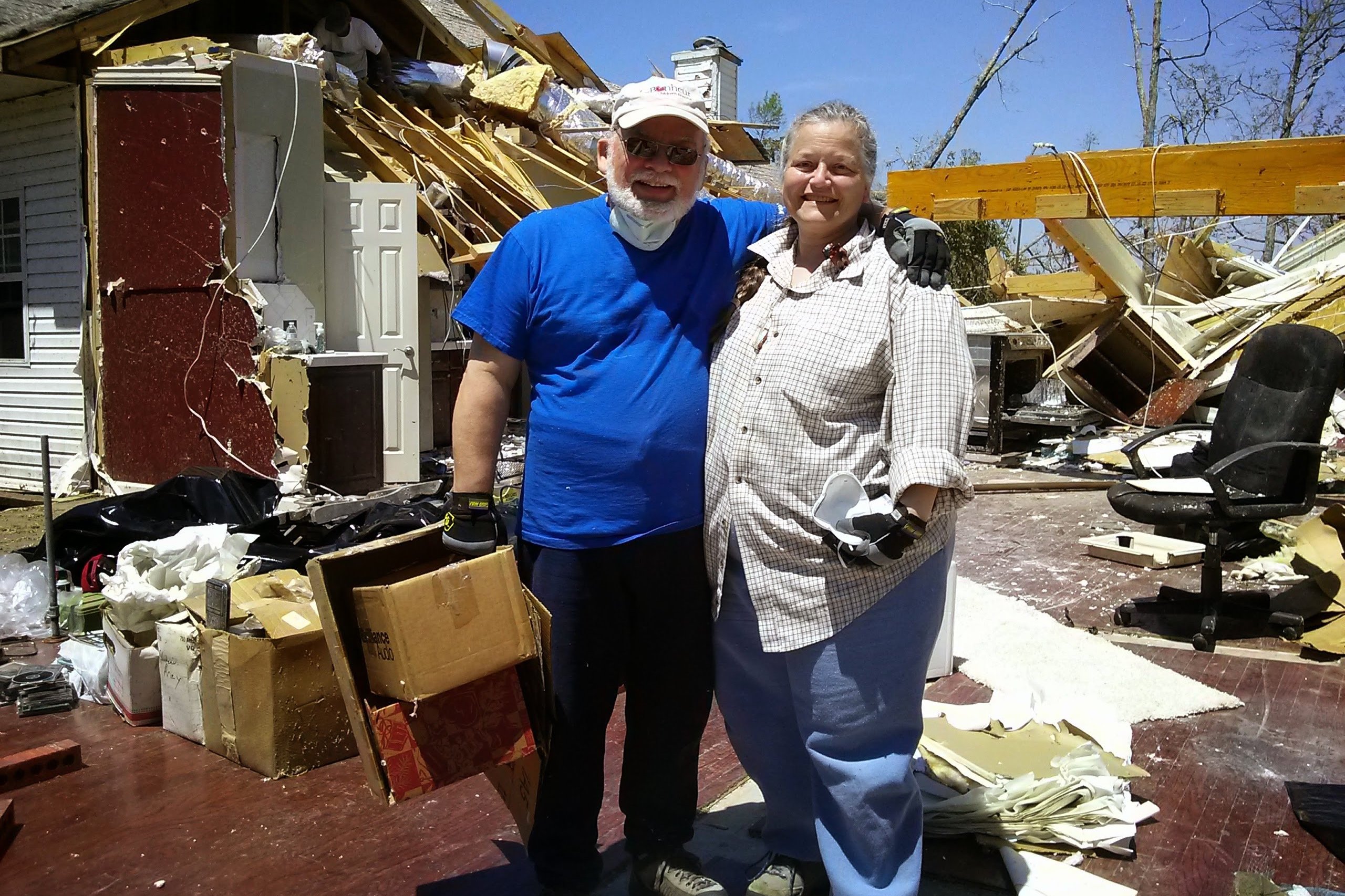 The Paron home of Sonny Albarado and his wife, Linda Lanier, was destroyed in the 2014 tornado that touched down in the area. The couple were away from their home — he returning from out of town, she running errands, then picking him up at the airport — while the home was hit. (Courtesy of Sonny Albarado)
The Paron home of Sonny Albarado and his wife, Linda Lanier, was destroyed in the 2014 tornado that touched down in the area. The couple were away from their home — he returning from out of town, she running errands, then picking him up at the airport — while the home was hit. (Courtesy of Sonny Albarado)
THE CATS ARE ALL RIGHT
In relaying the facts of the tornado that struck his Paron home in April 2014, Sonny Albarado, retired projects editor for the Democrat-Gazette, ticks off details with the dispassionate tone earned through decades in the newspaper business. But he's also not above savoring the more humorous elements of the story.
"I was out of town; I was in Indianapolis," he says. "Flew back that day with a stop in Chicago. As we flew in, the pilot announced we were taking a detour to avoid some really bad weather over Texas and western Arkansas. So, I knew there was some rainy weather or thunderstorms."
His wife, Linda Lanier, had been running errands before picking him up at the airport. The rain had stopped at that point.
"I was hungry, so we stopped at P.F. Chang's for dinner," Albarado remembers. "As soon as we ordered our meals, both of our phones started ringing. Mine was someone from the office wanting to know where I was and was I OK. Linda's was the neighbors wanting to know if we were OK. We were going, 'Yeah, why?' They said, 'Well, there was a tornado ... '"
"We told the servers at the restaurant, 'We just found out our house has been destroyed; would you just put our meals to go?'"
Things weren't as funny in real time, of course. Driving home, Albarado says, they were stopped by law enforcement posted to keep people out of the area, residents or not. The couple spent a fitful night in a hotel, wondering what they would find when let into their Brush Mountain neighborhood.
"We have [four] cats, and we were really worried about them," Albarado says. "The next morning, we got up and they still had it blocked off at Ferndale and Kanis but were letting residents into the area.
"We live on top of a ridge, and we could not drive our car up our driveway because of the trees that were down on it. We stopped at the bottom of the hill and walked up and got to see what the house looked like."
At the top of the ridge, the couple were surprised to see little damage as they faced the house. Then they opened the front door.
"When you walked through the entryway, all you saw was open sky," he says. "The middle of the house was just gone. There were rooms on the other side of the living area and they were destroyed, but parts of them were still standing. Shock started to set in at that point."
Albarado made his way through the areas of the house that looked safe to explore, including a bonus room over the garage where amazingly, most of the couple's 3,000 books were left unharmed just a few feet away from the missing section of home. There, something brushed his leg.
"One of the cats, Spot, came strolling up and rubbed against my calves," Albarado says. "The rest we found in the bedrooms. Mycroft crawled into the box springs under the bed. Footsie was in the closet and we had to crawl through the wreckage of that room to get to him. Pretty Face was lying on our bed just like nothing had happened."
The couple rebuilt their home on the same spot and live there today, even though Albarado admits to being considerably jumpier during storms since then.
"I don't know that we ever discussed the odds of getting hit by a tornado again," he says. "In the back of my mind, I figured it's possible there will be another tornado here. But I'm going to take my chances."
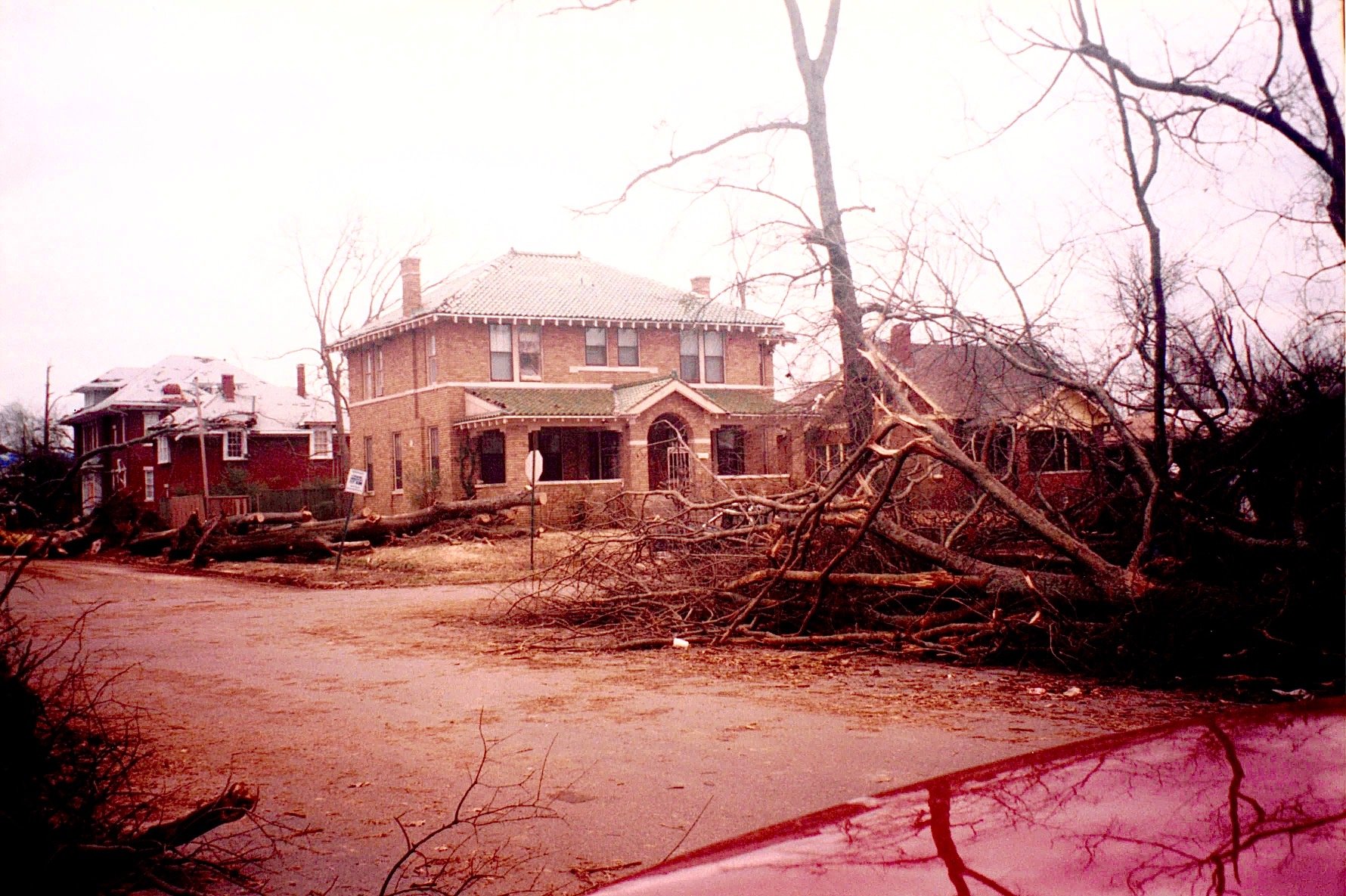 Amber and Scott Jones had guests over to their Little Rock home for dinner when the tornado of January 1999 struck and damaged their 2201 State Street home, damaged their vehicles and uprooted five 80-foot-tall oak trees around the house. (Courtesy of Amber and Scott Jones)
Amber and Scott Jones had guests over to their Little Rock home for dinner when the tornado of January 1999 struck and damaged their 2201 State Street home, damaged their vehicles and uprooted five 80-foot-tall oak trees around the house. (Courtesy of Amber and Scott Jones)
GUESS WHO'S COMING TO DINNER
To say Amber and Scott Jones' attitude toward tornadoes was laissez-faire prior to the evening of January 21, 1999, is something of an understatement, as the Little Rock couple now remembers.
"The day that all this happened, there were news reports of all this weird weather happening," Amber recalls. "Outside, everything kind of went to this electric green color. But still, we couldn't be bothered; we were having people over."
The couple had scheduled a dinner date with a co-worker's family and Amber remembers spending all day making homemade pot pies for the meal. As neither Scott nor Amber had had a serious run-in with a tornado, preventing the food from going to waste took precedence over a little wind.
"[The guests] called about 2:30, 3 o'clock, because they were supposed to come over at 5 or something," Amber says. "We both said, 'The sirens are going off but nothing's happening. Sure, come on over.' I mean, we were just such idiots because we didn't understand. I was like, 'Oh, yes. I've got dinner prepared. Please come over. We'd love to have you.'"
The guests arrived, a couple and their two young children, at the Jones home, located at 2201 State Street. One of the guests, a young boy, was shaken just at the thought of the rough weather that was being forecast. The adults wrote the child off as being overly sensitive, but today Amber insists the lad had a "sixth sense" about what was about to play out.
"As soon as we all gathered to sit down, the kid was asking about the lights going out, what will we do," Amber says. "Scott got the flashlight and put it in the middle of the table like it was a centerpiece bouquet. And I swear, almost as soon as he did that, all the action started."
As if on cue, a noise descended on the house that Scott described as being "like a chainsaw," loud enough that people seated at the table had to yell to be heard. The storm was on top of them, and they reflexively dove under the dining room table. Huddled under there, they could hear the mayhem playing out around them.
"This house had six windows across the front porch, and we were fortunate that it had a front porch all the way across, because it kept the windows downstairs from breaking in on us," Amber says. "Upstairs had like, four windows across the front of it. All of those windows and storm windows had debris fly through them. We could hear glass breaking all over the house."
When it got quiet, the group headed for the home's unfinished basement, where they sat briefly in the dark. Scott was the first to venture upstairs and he gave the all-clear, giving the family the first look at what the tornadoes had left behind. The first things they saw were the five 80-foot-tall oak trees around the house that had been uprooted.
"My truck was cut in half," Scott says. "Their van was cut in half. I called another co-worker and said, 'Hey, we got hit. Can you come get Mark and his family and take them home?' He worked his way into the neighborhood; we had to crawl through the trees to get the car seats out of his van."
The Joneses, along with the rest of Arkansas, would soon learn what had roared through their historic neighborhood damaged hundreds of homes, claimed three lives and was one of 107 twisters that would touch down in the state Jan. 21 and 22. And, not surprisingly, it changed forever how the couple responds to severe weather.
"We've become extremely cognizant," Amber says. "We understand the difference between a watch and a warning now. We very much pay attention to it now."
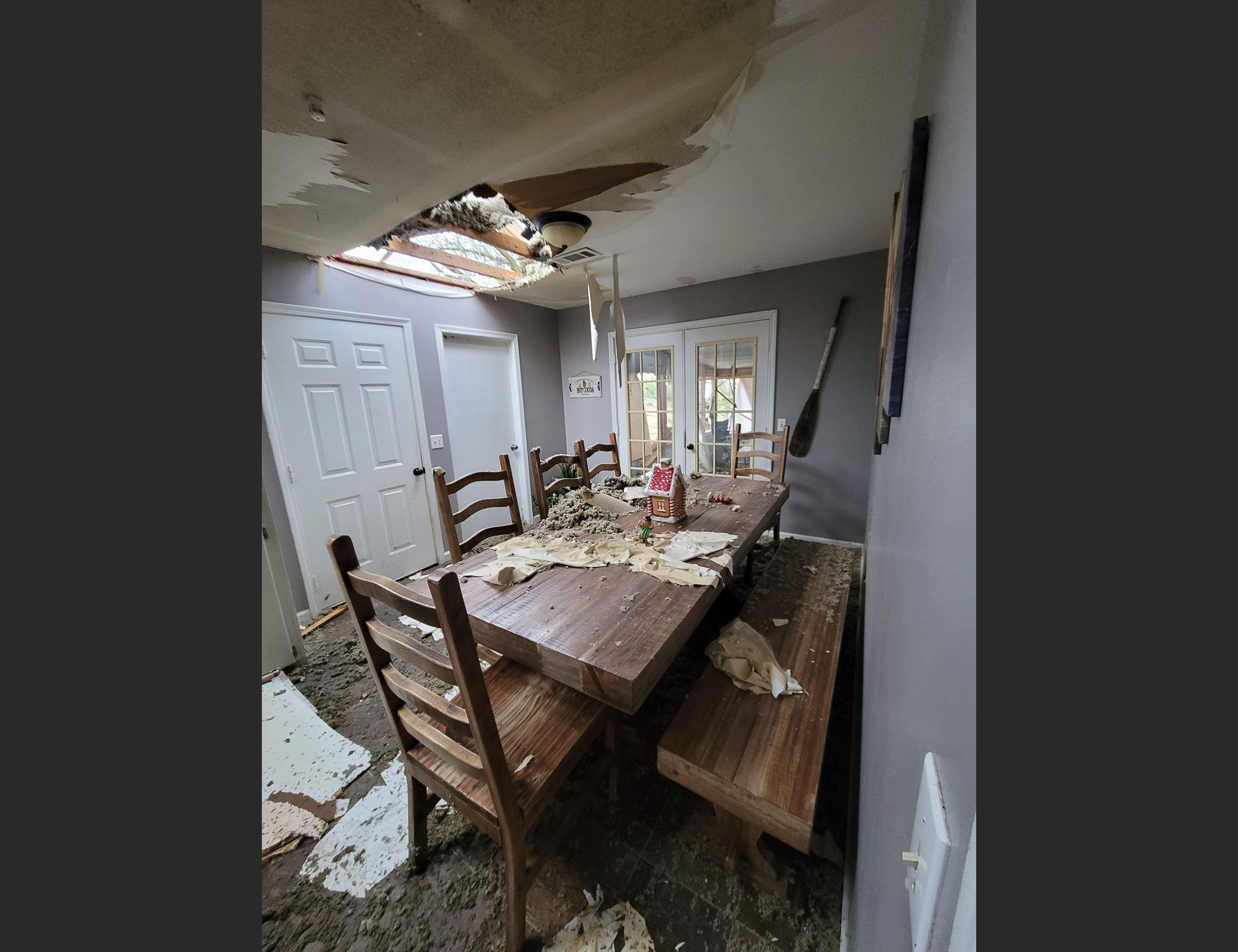 Alena Nichols has stood in the path of two tornadoes in her life. The second was in December, when she and her family found themselves in the path of a twister that struck Augusta. She says God got them through the storm, which destroyed their home. (Courtesy of Alena Nichols)
Alena Nichols has stood in the path of two tornadoes in her life. The second was in December, when she and her family found themselves in the path of a twister that struck Augusta. She says God got them through the storm, which destroyed their home. (Courtesy of Alena Nichols)
'THE LORD WAS IN THE WIND'
Alena Nichols has stood in the path of two tornadoes in her life. The first, in 2017 in Higginson, she hugged her son Rowdy as they prayed together during 15 seconds of sheer, roaring terror. Emerging the next day, she saw her neighbor's roofs torn off and cars flipped over. She looked at her own house.
"We only had a shingle missing, by the hand of God," she says. "My son looked at me and he said, 'Mama, Jesus saved us.' I said, 'He sure did, buddy.'"
Nichols says that even though she was just coming into her faith then, she knew something greater than the storm had prevailed that night. So last December, when she and her family found themselves in the path of a twister that struck Augusta, she knew her family would be protected.
"The other tornado was real. Like, you could feel the wind," she says. "This one here, when I got in the closet and the family were all praying, I was praying with them, but I just felt a sense of peace. Maybe it was just the peace of God among all of us, because we're a family that prays together. I just believe that it was peace within us."
Nichols' outlook is all the more amazing considering the damage that the family's home suffered. Their neighborhood, cut out of a pine forest with plenty of towering trees offering tranquil seclusion, was decimated by the storm. The family's home was broken in half and the part that came loose landed on their vehicles. And 60- to 80-foot trees lay everywhere like broken matchsticks.
"Before the storm, you couldn't see the main highway and we're off that," says Shandon Nichols, Alena's husband. "You couldn't see my daughter's house from my house which is three blocks away. Now you can see plumb to the highway. Any house in the neighborhood, you can see because the trees are gone.
"There are, like, 38 homes in this neighborhood and 10 of them were destroyed. Ours was one of them."
Once Shandon saw his own family was safe, he went into action to check on other residents of this Woodruff County hamlet. A former first responder, he considers it part of the code of living in a small town.
"I was a police officer and [I worked at a] fire department too, so I was used to going out and being the one helping," he says. "I checked all the houses on my street. I drove my truck through neighbors' yards, dodging around some pine trees to get over to the next block. All night long I was doing that."
Morning brought the devastation into full focus, but it wasn't the carnage the family remembers most about the day after. What sticks out are the legions of people who drove up and started lending a hand.
"We had so many people come. Not just to help us, because when they got done with us, they went to our neighbors," Shandon says. "We had a guy that I met one time in 2013 and he brought $300,000 worth of brand-new equipment and dropped it off at my house and said, 'Use it.' We had to figure out how to work the thing. He said, 'When you get done, you go to somebody else's house.' That's what we did, people just helping each other like we're supposed to do."
For Alena, the outpouring was nothing short of manifested grace.
"I believe with all my heart that we all go through things in life and at times we don't understand why and at times we might suffer, but we never suffer like Jesus and so we hang on," Alena says. "I believe this is a big testimony for everyone to see God's strength through us and His power being manifested. It's bringing everybody together.
"It was just phenomenal how God just totally made a way. Me and Shandon were just talking about how that's what God wants, people to help one another and be there for each other. If it took that tornado for us all to come together, then so be it."
